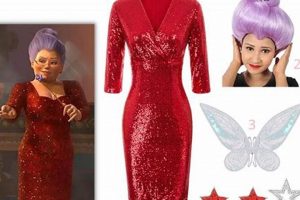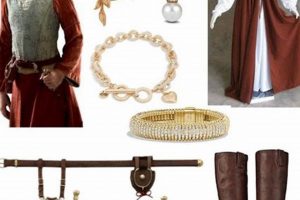Creating a homemade version of the iconic yellow ballgown and related attire offers an opportunity for individual expression and customization. This approach to character replication allows for the selection of fabrics, embellishments, and design elements that reflect personal preferences and budget constraints. For example, a parent might opt for durable, washable materials for a child’s play costume, or a cosplayer might choose luxurious textiles for a more elaborate, accurate representation.
The act of constructing such an ensemble presents several advantages. It fosters creativity, promotes resourcefulness, and provides a sense of accomplishment. Furthermore, constructing it can be more economical than purchasing a commercially produced, often mass-produced, garment. Historically, the creation of clothing and costumes was a common practice, reflecting a time when individuals had more direct control over their personal appearance and sartorial choices. This harkens back to a tradition of resourcefulness and skillful craftsmanship.
The subsequent sections will delve into specific approaches to realize this endeavor, encompassing pattern selection, fabric considerations, construction techniques, and accessory options. Guidance will be provided to help individuals successfully navigate the process from initial concept to final product.
Achieving a Successful Belle-Inspired Creation
The following guidelines aim to assist in the development of a visually appealing and structurally sound recreation of the attire associated with the character Belle, focusing on effective and resourceful techniques.
Tip 1: Precise Measurement Acquisition: Accurate body measurements are fundamental to a well-fitting garment. Utilize a flexible measuring tape and record dimensions meticulously, ensuring the tape remains level and taut against the body. Discrepancies in measurement can lead to significant alterations later in the construction process.
Tip 2: Pattern Alteration Considerations: Commercial patterns are often designed to fit standard body types. Evaluate the pattern against individual measurements and make necessary alterations to the bust, waist, hips, and torso length prior to fabric cutting. Muslin mock-ups are highly recommended to test fit adjustments before committing to the final fabric.
Tip 3: Fabric Selection for Drape and Durability: The choice of fabric significantly impacts the garment’s overall appearance and longevity. For the iconic ballgown, consider fabrics with good drape, such as satin, crepe, or chiffon. Interfacing can add structure to the bodice and skirt, influencing the silhouette. Prioritize durable and easy-to-care-for fabrics for children’s costumes.
Tip 4: Understructure Enhancement: The character’s ballgown often incorporates an underlying structure to achieve its voluminous shape. Petticoats, hoop skirts, or crinolines can be employed to create the desired silhouette. Evaluate the weight and stiffness of the understructure material to ensure comfortable wear.
Tip 5: Strategic Embellishment Application: Appliqus, sequins, and beads can enhance the visual appeal of the creation. Apply embellishments strategically to highlight key design elements, such as the bodice or skirt hem. Consider using fabric glue or hand-sewing techniques for secure attachment.
Tip 6: Zipper and Closure Integration: Secure and concealed closures are essential for a polished finish. Invisible zippers, hook-and-eye closures, or laced corsets are common options. Practice zipper insertion techniques on scrap fabric before applying them to the final garment.
Tip 7: Seam Finishing Techniques: Unfinished seams can unravel and detract from the garment’s overall appearance. Employ techniques such as serging, zigzag stitching, or bias tape binding to enclose raw edges and enhance durability.
Successful application of these techniques will lead to a well-constructed and visually striking representation of the Belle-inspired attire. This will result in a cost-effective and personalized result that captures the essence of the character’s iconic look.
The subsequent discussion will address frequently encountered challenges and provide solutions for overcoming potential obstacles in the creation process.
1. Pattern Selection
The selection of an appropriate pattern is a foundational element in the successful creation of a “princess belle diy costume.” The pattern dictates the overall design, fit, and construction complexity of the garment. An ill-fitting or poorly designed pattern can result in a costume that deviates significantly from the intended aesthetic, leading to dissatisfaction with the final product. For example, a pattern lacking sufficient fullness in the skirt will fail to replicate the iconic ballgown silhouette, regardless of the quality of materials used. Conversely, a pattern that is overly complex for the constructor’s skill level can result in frustration and an unfinished project.
The availability of commercial patterns varies, with some offering a simplified interpretation of the character’s attire and others striving for historical accuracy. Selecting a pattern that aligns with the constructor’s skill level and desired level of detail is crucial. Modifications to existing patterns are often necessary to achieve a precise fit or incorporate specific design elements. This may involve adjusting the bodice length, altering the sleeve shape, or adding embellishments. Furthermore, some constructors opt to draft their own patterns, allowing for complete control over the design process but requiring advanced pattern-making skills.
In summary, pattern selection directly impacts the visual fidelity and wearability of a fabricated character costume. Careful consideration of pattern design, fit, and construction complexity, combined with the potential for pattern modification, are essential for achieving a high-quality result. Overlooking this crucial step can lead to significant challenges later in the construction process, potentially compromising the final outcome.
2. Fabric Choice
Fabric choice functions as a determinant in the overall success of a homemade rendition of the character’s iconic attire. The selection process directly impacts the costume’s visual appeal, drape, durability, and overall wearability. Inappropriate fabric selection can lead to a garment that fails to capture the essence of the character’s aesthetic. For instance, a stiff, unyielding fabric will prevent the creation of the flowing ballgown silhouette, while a flimsy or transparent material may lack the necessary structure and opacity. Conversely, a carefully selected fabric can elevate the costume, providing a luxurious and authentic appearance. Consider, for example, the difference between using a budget-friendly broadcloth versus a higher-quality satin for the main dress. The satin, with its inherent
sheen and drape, will invariably produce a more visually compelling result.
Beyond aesthetics, fabric choice also affects the garment’s functionality and longevity. Fabrics prone to wrinkling or tearing will require frequent maintenance and may not withstand repeated wear. Similarly, fabrics that are difficult to clean or prone to shrinking can present practical challenges for the costume’s owner. For children’s costumes, durability and washability are paramount considerations, suggesting the selection of more robust materials like cotton blends or polyester. Furthermore, the weight and breathability of the fabric will impact the wearer’s comfort, particularly during extended periods of wear or in warmer climates. A heavy, non-breathable fabric can quickly become uncomfortable, detracting from the overall experience.
In conclusion, the selection of appropriate fabrics is crucial for achieving a successful character portrayal. Fabric choice directly influences the costume’s visual impact, durability, and wearability. Thoughtful consideration of fabric properties, including drape, weight, texture, and maintenance requirements, is essential for creating a homemade garment that is both visually appealing and practically functional. Overlooking these considerations can lead to a costume that is either aesthetically disappointing or impractical for extended use.
3. Skill Level
The constructor’s proficiency, or “skill level,” represents a critical determinant in the success of a self-made recreation of the “princess belle diy costume.” This competency directly influences the complexity of design elements, fabrication techniques, and the overall quality of the finished garment. Inadequate skill can limit the execution of intricate details, while advanced proficiency allows for greater precision and accuracy in replicating the character’s iconic attire.
- Pattern Interpretation and Adjustment
The ability to accurately interpret commercial patterns and make necessary adjustments for fit is essential. Individuals with limited experience may struggle with deciphering pattern markings, cutting fabric accurately, and understanding seam allowances. Adjusting patterns to accommodate unique body shapes requires a deeper understanding of garment construction principles. For example, adapting a bodice pattern to fit a fuller bust or lengthening a skirt requires knowledge of pattern alteration techniques that novice sewers may lack.
- Fabric Manipulation and Sewing Techniques
Proficiency in various sewing techniques, such as gathering, pleating, inserting zippers, and finishing seams, is crucial for creating a professional-looking garment. Complex designs may require advanced techniques like boning, draping, or couture finishing methods. For instance, creating the voluminous skirt of the ballgown often involves gathering large amounts of fabric, a technique that requires practice and precision to achieve even distribution and prevent puckering. Similarly, neatly inserting an invisible zipper is a skill that requires patience and a steady hand.
- Embellishment and Detailing
The addition of embellishments, such as lace, beads, appliques, and embroidery, can significantly enhance the visual appeal of the costume. However, applying these details requires skill and precision. Novice constructors may struggle with techniques like hand-sewing delicate trims or creating intricate embroidery designs. The placement and attachment of embellishments can also impact the garment’s overall balance and aesthetic, requiring an eye for design. Examples include the application of roses or other floral details on the bodice or skirt.
- Problem Solving and Adaptability
Garment construction often presents unexpected challenges, requiring problem-solving skills and adaptability. Experienced sewers are better equipped to troubleshoot issues such as fabric snags, machine malfunctions, or fit problems. They can also adapt techniques and materials as needed to overcome obstacles. For example, if a desired fabric is unavailable, a skilled constructor can identify a suitable substitute and modify the pattern or construction method accordingly. A novice may struggle to address these challenges independently, leading to frustration and potentially compromising the final outcome.
The successful creation of a “princess belle diy costume” hinges significantly on the constructor’s skill level. A thorough assessment of one’s capabilities, coupled with a realistic approach to pattern selection, fabric choice, and design complexity, is essential for achieving a satisfying and high-quality result. While ambitious projects can be rewarding, it is advisable for beginners to start with simpler designs and gradually progress to more challenging endeavors, thereby building their skills and confidence. Ultimately, a realistic understanding of one’s skill level is crucial for setting achievable goals and maximizing the chances of a successful project.
4. Budget Constraints
The financial parameters, or “Budget Constraints,” represent a significant factor influencing the realization of a self-made version of the iconic yellow ballgown and associated attire. Cost limitations directly impact material selection, construction techniques, and the overall level of detail achievable in the final product. Limited financial resources may necessitate compromises in fabric quality, embellishment choices, and the complexity of the design. For instance, opting for less expensive fabrics, such as polyester blends instead of silk or satin, represents a common strategy to reduce material costs. Similarly, simplifying the design by omitting elaborate details, such as intricate embroidery or extensive beadwork, can also significantly lower the overall expense. A well-managed budget necessitates careful prioritization of resources, balancing the desire for visual accuracy with the practical realities of cost-effectiveness.
The impact of budgetary limitations extends beyond material selection. Construction techniques may be adapted to minimize material waste or reduce the need for specialized tools and equipment. For example, hand-sewing embellishments instead of using a sewing machine can save on equipment costs, albeit at the expense of increased labor. Furthermore, resourceful constructors may repurpose existing materials, such as fabric scraps or discarded garments, to reduce the need for new purchases. Online marketplaces and discount fabric stores provide additional avenues for sourcing affordable materials. These strategies, while effective in controlling costs, often require additional time and effort in planning and execution. The availability of free or low-cost patterns can also alleviate expenses, compared to purchasing more complex or licensed designs.
In summary, financial limitations fundamentally shape the construction process, requiring strategic decision-making and creative problem-solving. While budgetary restrictions may necessitate compromises, they also foster resourcefulness and encourage the exploration of alternative approaches. Careful planning, material selection, and construction techniques can mitigate the impact of budgetary limitations, enabling the creation of a visually appealing and functionally satisfactory attire within defined financial parameters. Overlooking these constraints can lead to cost overruns and an unfulfilled project, underscoring the importance of p
roactive budget management in the pursuit of a homemade character representation.
5. Time Commitment
The allocation of time constitutes a critical factor in the creation of a self-made version of the iconic yellow ballgown and related attire. The hours dedicated to this endeavor directly influence the complexity, detail, and overall quality of the finished product. Insufficient time investment may result in a rushed and poorly executed costume, while adequate time allows for meticulous attention to detail and a more polished final result.
- Pattern Preparation and Adjustment
The process of acquiring, tracing, cutting, and adjusting the chosen pattern consumes a significant portion of the overall time commitment. Commercial patterns often require modifications to achieve an accurate fit. This may involve altering the bust, waist, hip, or torso length. Complex pattern designs with multiple pieces require more time for preparation. For instance, adjusting a multi-sized pattern for a child’s unique measurements can take several hours.
- Fabric Cutting and Preparation
The precise cutting of fabric pieces, following pattern layouts, demands careful attention and precision. Fabric preparation, such as washing and ironing, is also necessary to prevent shrinkage and ensure accurate cutting. Complex designs with multiple fabric layers or embellishments require more time for cutting and layering. For example, cutting out the individual pieces for a fully lined bodice can take an entire afternoon.
- Sewing and Construction
The actual sewing process represents the most time-intensive aspect of costume creation. Complex construction techniques, such as gathering, pleating, inserting zippers, and applying embellishments, require significant time investment. Hand-sewing details, such as lace or beadwork, can add considerable time to the project. Constructing the voluminous skirt of a ballgown, with its multiple layers and intricate details, can take several days or even weeks.
- Finishing and Alterations
The final stages of costume creation, including seam finishing, hemming, and making necessary alterations, are crucial for achieving a polished and professional look. Fitting the costume on the intended wearer and making adjustments to ensure a comfortable and flattering fit can require multiple iterations. Adding finishing touches, such as ironing, steaming, and accessorizing, also contribute to the overall time commitment. For example, adjusting the hemline of a floor-length gown to achieve the perfect length can take several hours.
These factors collectively underscore the importance of realistic time planning when embarking on a homemade character recreation project. A proper assessment of available time, coupled with a clear understanding of the project’s complexity, is essential for achieving a satisfying and high-quality result. Rushing through the construction process to meet a deadline can compromise the final outcome, while allocating sufficient time allows for greater attention to detail and a more rewarding creative experience.
Frequently Asked Questions
This section addresses common inquiries and concerns regarding the construction of a homemade version of the character’s iconic attire. Clarity on these points will assist individuals in planning and executing a successful project.
Question 1: What are the essential components required for the creation of a homemade version?
The fundamental components include a well-fitting pattern, appropriate fabric, sewing notions (thread, needles, zippers), measuring tools, and a sewing machine (though hand-sewing is possible). Optional components may include embellishments like lace, beads, or appliques, and understructure elements like petticoats or hoops.
Question 2: How can fabric costs be minimized without sacrificing quality?
Strategies to reduce fabric expenses include searching for sales and discounts, comparing prices at different retailers, repurposing existing fabrics, utilizing coupons, and considering less expensive fabric alternatives that still maintain a desirable appearance and durability.
Question 3: Is prior sewing experience necessary to create a replica of the costume?
While prior sewing experience is beneficial, it is not strictly mandatory. Individuals with limited or no prior experience can still undertake the project by selecting simpler patterns and utilizing online tutorials. However, it is advisable to practice basic sewing techniques before commencing the project.
Question 4: What is the estimated time commitment for completing a homemade rendition?
The time required varies significantly depending on the complexity of the design, the skill level of the constructor, and the availability of time. A simple costume may take several days to complete, while a more elaborate design could require weeks or even months.
Question 5: How can the fit of the costume be ensured, particularly for children?
Accurate measurements are paramount. Compare the measurements to the pattern size chart and make necessary adjustments to the pattern before cutting the fabric. Constructing a muslin mock-up to test the fit before using the final fabric is highly recommended.
Question 6: What are the most common challenges encountered during the construction process, and how can they be overcome?
Common challenges include pattern interpretation, fabric cutting errors, sewing machine malfunctions, and fit issues. These challenges can be mitigated by carefully reading the pattern instructions, using sharp scissors, maintaining the sewing machine, and seeking assistance from experienced sewers or online resources.
Addressing these common questions prior to starting the project can improve efficiency and reduce potential frustrations. A thorough understanding of these aspects contributes significantly to a successful outcome.
The succeeding segment will explore potential variations and adaptations to the core design, offering insights into customizing the costume for individual preferences.
princess belle diy costume
The preceding discourse has explored the multifaceted aspects of crafting a homemade recreation of the character’s iconic attire. Key considerations include meticulous pattern selection, appropriate fabric procurement, an honest evaluation of skill level, adherence to budgetary restrictions, and realistic time allocation. Successful navigation of these elements results in a personalized and potentially cost-effective representation of the character.
The endeavor of creating a “princess belle diy costume” is not merely an exercise in replication, but an opportunity to engage in creative expression and resourceful craftsmanship. Individual interpretation and adherence to sound construction principles will ultimately determine the success and longevity of the finished product. The commitment to quality and attention to detail are paramount in achieving a visually compelling and structurally sound result, underscoring the significance of informed planning and diligent execution.







